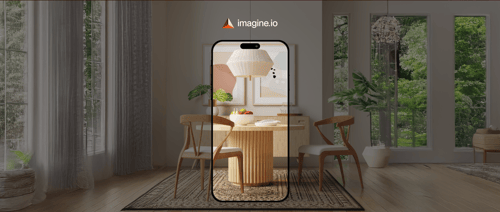In the ever-evolving world of eCommerce, winning a customer’s trust and driving conversions hinge on one key factor: how effectively you showcase your product online. With rising customer expectations and shrinking attention spans, traditional product photography is no longer enough. Today’s shoppers want to see, explore, and even personalize products—just as they would in a physical store.
That’s where 3D product visualization comes in. More than just a visual upgrade, 3D renders and configurators offer immersive, interactive experiences that elevate product pages, reduce uncertainty, and significantly boost conversion rates.
In this blog, we’ll explore how 3D visualization is reshaping the online shopping journey, backed by data, real-world brand examples, and actionable insights. Whether you're a marketer, eCommerce manager, or business owner, you'll learn why now is the right time to integrate 3D into your product strategy—and how to get started.
Get the latest updates straight to your inbox.
By clicking sign up you'll receive occasional emails from imagine.io. You always have the choice to unsubscribe within every email you receive.
The Growing Role of 3D Visualization in eCommerce
In today’s fiercely competitive eCommerce market, capturing and keeping a shopper’s attention is everything. Static product images no longer cut it. Consumers crave engaging, immersive experiences that allow them to interact with a product before buying it.
That’s where 3D product visualization steps in—transforming the online shopping experience and driving real business results.
According to Shopify, merchants using 3D product models can see conversion rate increases of up to 94%.
These interactive visual assets bridge the gap between physical and digital retail by helping customers better understand a product's form, function, and fit—before it even arrives.
Enhancing Customer Confidence with Interactive Product Exploration
Customer hesitation is one of the biggest barriers to purchase online. Without the ability to touch or try a product, buyers are often unsure whether what they see is what they'll get. 3D product visualization eliminates this friction.
With tools that allow shoppers to rotate, zoom, and view products from every angle, users gain a tactile sense of detail and scale—features static photos can’t deliver.
A recent study found that 66% of shoppers say having a 3D configurator boosts their buying confidence.
Additionally, combining 3D visualization with real-time customization options—such as material swatches, finishes, and modular layouts—can empower customers to explore and personalize products. This deep engagement not only boosts satisfaction but increases the likelihood of a completed purchase.
Why This Matters:
- Informed buyers are more likely to convert.
- Interactive exploration replicates in-store experiences.
- Personalization strengthens emotional connection to the product.
Real Impact on Return Rates and Buyer Expectations
Returns are costly. They chip away at margins, slow operations, and can erode customer trust. But when customers receive exactly what they expected, they're less likely to send it back.
Brands using 3D product visuals have seen return rates drop by up to 40%, as reported by Shopify.
The reason is simple: rich visualizations align customer expectations with reality. Buyers know what the product will look like in their space and how it compares to what they imagined—eliminating unpleasant surprises.
This benefits compounds over time. With better expectations and lower returns, customers build trust and loyalty with your brand. Repeat buyers cost less to acquire and deliver higher lifetime value.
Key Benefits:
- Reduced costs from returns and exchanges
- Improved customer satisfaction and NPS scores
- Long-term customer retention
Real-World Success: How Brands Are Applying 3D Visualization
Leading eCommerce brands across verticals are seeing tangible gains from 3D implementation:
- Furniture: Companies like IKEA and Wayfair use 3D models and AR features to let users visualize products in their own homes, reducing purchase anxiety and driving higher conversions.
- Apparel & Footwear: Brands showcase stitching detail, fabric drape, and fit, helping customers make more informed sizing and styling choices.
- Consumer Electronics: Using exploded views, 360-degree spins, and animations, tech brands explain complex product features in a user-friendly way.
In each case, 3D content is not just a visual upgrade—it’s an integral part of the brand’s value proposition. When executed well, it positions the business as innovative, customer-first, and technologically advanced.
According to Mckinsey, 71% of consumers expect companies to deliver personalized and immersive experiences. 3D visualization plays a critical role in meeting this demand.
Final Thoughts: Why Now is the Time to Invest in 3D
3D product visualization isn't a futuristic nice-to-have. It's a proven driver of eCommerce performance today. As shoppers grow more sophisticated and demand deeper digital experiences, the brands that meet them with immersive, informative visuals will win the sale.
Investing in 3D now gives you a critical edge—from higher conversions and lower returns to brand differentiation and long-term loyalty.
Start small:
- Begin with your hero SKUs
- Use A/B testing and track key metrics like conversion rate, time-on-page, and return rate
- Iterate based on performance and expand accordingly
Pro tip: Platforms like imagine.io make it easier than ever to get started at scale—without heavy technical overhead or long production cycles.


.gif?width=1296&height=1296&name=Untitled%20design%20(8).gif)




.png?width=500&name=How%20to%20Add%20a%203D%20Product%20Configurator%20to%20Your%20WordPress%20Website%20(Complete%20B2B%20Guide).png)
















%20(1).png?width=500&name=Why%20Exploded%20Mattress%20Views%20Matter%20(And%20How%20to%20Generate%20Them)%20(1).png)
.png?width=500&name=Best%20Shopify%20Product%20Configurator_%20How%20to%20Choose%20the%20Right%20One%20(2).png)
.png?width=500&name=Why%20Exploded%20Mattress%20Views%20Matter%20(And%20How%20to%20Generate%20Them).png)



.png?width=500&name=Best%20Shopify%20Product%20Configurator_%20How%20to%20Choose%20the%20Right%20One%20(1).png)







.png?width=500&name=How%203D%20Rendering%20Can%20Make%20or%20Break%20Your%20Industrial%20Design%20Pitch%20(1).png)








%20with%20Digital%20Twins%20and%203D%20Visualization.png?width=500&name=Optimizing%20Your%20Digital%20Asset%20Management%20(DAM)%20with%20Digital%20Twins%20and%203D%20Visualization.png)




.png?width=500&name=Styling%20Home%20Decor%20for%202025_%20From%20Global%20Influences%20to%20Playful%20Personalization%20(1).png)
